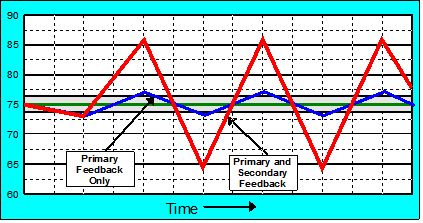|
 The blue line in the figure 2 shows the resulting temperature over time. It varies between 74
and 76 degrees. The blue line in the figure 2 shows the resulting temperature over time. It varies between 74
and 76 degrees.
Deadband--the thermostat starts or stops the furnace only
when the difference between set-point and room temperature is greater than about 1.0 degree.
Without this deadband, the furnace would cycle every few seconds with the minute temperature
changes. The deadband produces small temperature variance.
Time Delay--there is a time delay while the heat exchanger
heats or cools and this causes a further variation in room temperature. While the heat exchanger
is warming, the room temperature continues to fall; when the heat exchanger is cooling it
continues to heat the room even after the thermostat calls for shutdown.
This illustrates two reasons why feedback systems become unstable: time delays and
non-linearity.
Non-linearity refers to a response that is not proportional
to input. The dead-band is non linear. A small temperature change brings no response from the
thermostat. A slightly larger change starts the burner at full heat. The burner is either on or
off and is also non-linear. A burner that could modulate and produce heat in proportion to the
temperature difference between set-point and room temperature would be more linear and, thus,
more stable.
In this heating system, operating on its own, the time delays and non-linearity produce only
small oscillations and system instability is small. At times, an additional feedback loop is
introduced into a formerly stable heating system. This takes the form of a
thermostat fiddler-- people who attempt to improve on the
control system by changing the set-point frequently.
The red line in figure 2 shows the result. When the fiddler detects a slight decrease in
temperature, he/she raises the set-point to a very high setting, say 85 degrees. The thermostat
responds, the burner ignites and room temperature rises. Fiddlers rarely notice the rising
temperature until it reaches, say 80 degrees. They then respond by excessively lowering the of
set-point while cursing the defective furnace.
This illustrates amplification in the feedback loop. The
temperature difference is amplified disproportionately and over-correction results. The
thermostat fiddler also adds complexity and additional non-linearity.
|
|

Figure 2-- Heating System Response
Shows the temperature
response of the feedback
heating system with primary and secondary feedback loops. The secondary loop adds both
amplification and time delay that de-stabilizes the system.
|
Amplification is common when humans are part of a control system. With scheduling and
inventory systems, it results in excessively large batches of product and excessively large
inventory alternating with shortages.
Our heating system example illustrates several fundamental causes of instability and chaos:
-
Non-Linearity
-
Amplification
-
Time Delays
These factors can produce instability and chaos when present in any part of the system.
However, feedback loops are especially sensitive.

|





